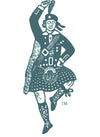When you visit Scotland you’re bound to come across Celtic symbols. You may spot them on items of traditional Highland dress, such as sporrans, belts and buckles, kilt pins and brooches.
You’ll also see many symbols used in jewellery items including cufflinks, necklaces, and earrings. And Celtic symbols are also commonly found on silver and pewter drink flasks and quaichs, or loving cups, used in Scottish weddings.
Scotland is very proud of its ancient and fascinating history which is why Celtic symbols are so prominent. This blog post takes a look at some of the most common Scottish Celtic symbols and the meanings behind them.
WHO ARE THE CELTS?

It is thought that Celtic culture stretches back to around 1200 BC when the Celtic people began to collect in tribes across central Europe. They shared a common language and a pagan culture. As they spread throughout Western Europe they took their language and culture and art with them.
Apart from ancient runic inscriptions, the Celts didn’t leave any written history. What we know about Celtic beliefs and mythology largely comes from early Irish and Welsh literature written from about 8AD. Although the Romans were the first to document the existence of the Celts and referred to them as ‘Galli’ or barbarians, who followed an ancient pagan religion overseen by druids. And as the Roman Empire spread, the Celtic people were pushed to the western margins of Spain and France, and to what was eventually to become Wales, Scotland and Ireland.
The legacy of the Celts is still very much with us today – in the Gaelic language of Irish and Scots, the Welsh language and in much of the shared music and artistic culture. All across Europe the Celts left their mark with intricate stone carvings – often using Celtic symbols, as well as fine metalworking. They were far from being the barbarians the Romans thought they were.
Celtic paganism revolved around nature and supernatural forces in sacred places such as rivers, lakes, and forests were worshipped. The Celts also revered the sun, moon and stars. Celtic symbols were used to represent these various ‘spirits’, the natural world, and the seasons.
SCOTTISH CELTS
The Scottish Celtic people lived in northern Britain at the time of the Roman invasion. The Romans called them the Picts and eventually gave up trying to conquer them. Instead Hadrian, the Roman Emperor of the time, had a stone wall built across Britain to keep them out of the south.
CELTIC KNOTS
Scottish Celts – like other Celtic people in Ireland, Wales and parts of Europe, often used intricate knot symbols as well as depictions of animals and everyday items in their metalwork.
Celtic knots are perhaps the most iconic of all the Celtic symbols and there are many different variations. It’s thought that Celtic knots were mainly used as decorative elements although they may have mostly symbolised eternity as they have no beginning or end.
Celtic knots can certainly be found on ancient Celtic monuments and in early Christian manuscripts such as the Book of Kells and the Lindisfarne Gospels.
COMMON SCOTTISH CELTIC SYMBOLS
- Sailor’s Knot

This simple but effective design is thought to have been created by sailors as a way of remembering family and friends. The strength of the knot could symbolise the strength of the bond between family members.
- Celtic Shield Knot

It is believed this simple but effective design symbolises strength and protection and would be used to ward off enemies. They could also have been placed outside homes, places of worship and near sick people to protect them from evil spirits.
- Celtic Trinity Knot – Triquetra

Like many other Celtic symbols the Triquetra, Trinity Knot, or Celtic Triangle, is based on three interlocking elements. The number ‘three’ was clearly significant in Celtic culture, reflecting their view that everything is interconnected and part of a continuum.
The early Christians adopted the Triquetra to represent the Holy Trinity. Over time, and especially after the Celtic Revival of the 1800s, this unending knot came to symbolise eternity and eternal love.
- Celtic Cross

The term ‘Celtic Cross’ first appears in the 1800s with the Celtic revival. Although there are examples of freestanding stone Celtic crosses that date back to the 8th century.
The Celts seem to have had an early symbol of a circle containing a cross to symbolise the sun. Although some think that the four arms of the cross may have represented the four seasons or even the four stages of a day (morning, midday, evening, and midnight).
When combined with the Christian cross, the design was used for upright stone crosses, typically richly decorated with versions of the Celtic knot. One of the finest surviving high crosses from this time is the Kildalton Cross on Islay in the Inner Hebrides, which stands 2.65 metres high, with arms 1.32 metres across.
- Triskelion

The three interlocking spirals of the Triskelion is associated with the Celtic god Triskele, who was a manifestation of the seasons. Every year he would be born, live and die – represented in the three spirals – bringing good fortune.
The Triskelion can also symbolise harmony between the three elements of earth, water and fire. And it can also represent the physical world, the spiritual realm and the celestial heavens.
- Dara Knot

Symbolising strength, particularly inner strength, the Dara Knot gets its name from the Irish Gaelic word for oak tree – doire. Celts and druids considered oak trees sacred and symbolic of power, strength, wisdom and endurance.
SCOTTISH CELTIC SYMBOLS AT HIGHLAND STORE
Many of our traditional Highland dress items are decorated with Scottish Celtic symbols. For instance, variations of Celtic knots can be seen on sporrans, belts and buckles, cufflinks, and kilt pins.
More elaborate Celtic designs are etched onto our range of pewter hip flasks and our dress sporrans, together with recurring Scottish symbols such as the thistle, stag and lion.



